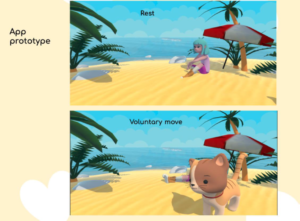Discovering your body
An application for discovering your body – Learning to feel and move your body to develop voluntary motor skills
Phase 2
Type of project : Prototype
Disability concerned: Multiple disability, Spastic tetraparesis, Cerebral palsy, Global developmental delay
Topics: Development of voluntary motor skills, Child development, Building the individual, Physical and mental well-being, Quality of life
Status: Completed
This project proposes an innovative application to enable children with severe motor disabilities to better understand and control their movements. To achieve this, we are replacing proprioception, which spastic tetraparesis tends to render inoperative and dysfunctional, with new visual information about the body and the quality of muscle contractions.
This project is a continuation of the exploratory research supported by the FRH. It focuses on support for children suffering from spastic tetraparesis, the most severe form of cerebral palsy. The severity of their disability makes them prisoners of a body that escapes them. The application translates muscle contractions by moving two small cats on a screen, one for each arm. In this way, children can ‘see’ their movements, understand and give meaning to their bodies.
Our aim is to make this device accessible and generalisable to a wider population with motor disabilities. Two children were chosen for their different pathologies, hypo- and hypertonic.
Three progressive levels have been developed to ensure that motor skills can be developed over time. Each level focuses on different motor components: 1) voluntary motor skills vs. spasms, 2) differentiated arm engagement, 3) strength of contraction. Each level is subdivided into spontaneous and on-demand motor skills. Success is rewarded with an attractive visual and musical show.
The 1st child, who has already been monitored, is in the middle of exploring the 2nd level. Her motor skills are now voluntary and she can spontaneously distinguish between her arms.
On demand, it’s still difficult. On a day-to-day basis, progress has been significant. In class, she now presses her switch to activate the recording. She even manages to feign when the teacher tries to take it away from her, only to press it a second time with a broad smile on her face. For the 2nd child, who joined us in September, we worked at length to find the best postural set-up to reduce his spasticity. To build up his confidence, we used peer learning by inviting him to a session with the 1st child. He very quickly understood how to make the cats move and his spasms began to diminish (1st level).
The first lesson learnt is the relativity of disability over time: supporting these children takes time, whereas progress only emerges over a longer duration. And it’s vital to follow this rhythm if you want to give success a chance!
The sessions with the 1st child confirmed our projections. However, the 2nd child turned our certainties upside down! We had to rethink the whole system to reduce his hyperextension reactions. His very high tactile sensitivity combined with the spasticity of his movements made us doubt the feasibility, as the wires were getting tangled up and the electrodes were pulling out.
This has enabled us to make progress in terms of new options for the measurements we’re going to implement (motion detector bracelets, wireless electrodes). Finally, we were blown away by the power of social interaction and peer learning. All it took was for the 2nd child to understand the situation with the 1st child for him to finally open up to learning.
To our knowledge, this type of technical device has never been used to support children with severe motor disabilities in developing their voluntary motor skills. It’s a question of touching on the very dynamics of development that enable voluntary motor skills to emerge and, in so doing, build their body schema.
In this sense, our approach is particularly innovative.
Once the device is fully functional, we would like to develop research on a larger scale to verify our hypotheses that offering sensory feedback (in this case visual and auditory) to children with multiple disabilities supports the development of their voluntary motor skills. An application to Innosuisse is currently being prepared.

Contact info
HES-SO, HETS-Genève, Filière Psychomotricité
Chantal Junker-Tschopp
